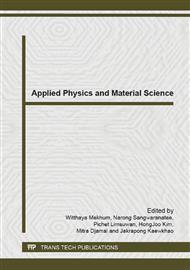[1]
S. Mitatha, R. Putthacharoen, P.P. Yupapin, THz frequency bands generation for Radio-over-Fiber systems, Optik 123 (2012) 974– 977.
DOI: 10.1016/j.ijleo.2011.07.013
Google Scholar
[2]
IEEE standard for local and metropolitan area networks part 16: air interface for fixed broadband wireless access systems, IEEE Std 802. 16-2004, 2004 (Revision of IEEE Std 802. 16-2001).
DOI: 10.1109/ieeestd.2004.226664
Google Scholar
[3]
IEEE standard for local and metropolitan area networks part 16: air interface for fixed and mobile broadband wireless access systems amendment 2: physical and medium access control layers for combined fixed and mobile operation in licensed bands and corrigendum 1, IEEE Std 802. 16e-2005 and IEEE Std 802. 16-2004/Cor 1-2005, 2005 (Amendment and Corrigendum to IEEE Std 802. 16-2004).
DOI: 10.1109/ieeestd.2006.99107
Google Scholar
[4]
IEEE standard for local and metropolitan area networks part 16: air interface for fixed and mobile broadband wireless access systems, IEEE Std 802. 16TM-2009 IEEE Standard for Local and metropolitan area networks, (2009).
DOI: 10.1109/ieeestd.2004.226664
Google Scholar
[5]
Andrews, J., Ghosh, A., & Muhamed, R. (2007). Fundamentals of WiMAX: Understanding Broadband Wireless Net-working. Upper Saddle River, NJ: Prentice Hall.
Google Scholar
[6]
F. Xiong, W. D. Zhong, and H. Kim, A broadcast-capable WDM passive optical network using offset polarization multiplexing, J. Lightwave Technol. 30, 2329-2336 (2012).
DOI: 10.1109/jlt.2012.2196756
Google Scholar
[7]
E. Wong, Next-Generation Broadband Access Networks and Technologies, J. Lightwave Technol. 30, 597-608 (2012).
DOI: 10.1109/jlt.2011.2177960
Google Scholar
[8]
Z. A. El-Sahn, J. M. Buset, and David V. Plant, Overlapped-subcarrier multiplexing for WDM passive optical networks: experimental verification and mathematical analysis, J. Lightwave Technol. 30, 754-763 (2012).
DOI: 10.1109/jlt.2011.2180510
Google Scholar
[9]
R.C. Myers, M.H. Mikkelsen, J.M. Tang, A.C. Gossard, M.E. Flatte, and D.D. Awschalom, Zero-field optical manipulation of magnetic ions in semiconductors, Nat. Mater. 7, 203-208 (2008).
DOI: 10.1038/nmat2123
Google Scholar
[10]
D.F. Gordon, B. Hafizi, and A. Ting, Nonlinear conversion of photon spin to photon orbital angular momentum, Opt. Lett. 34, 3280-3282 (2009).
DOI: 10.1364/ol.34.003280
Google Scholar
[11]
O. Ozatay, P.G. Gowtham, K.W. Tan, J.C. Read, K.A. Mkhoyan, M.G. Thomas, G.D. Fuchs, P.M. Braganca, E.M. Ryan, K.V. Thadan, J. Silcox, D.C. Ralph, and R.A. Buhrman, Sidewall oxide effects on spin-torque and magnetic-field-induced reversal characteristics of thin-film nanomagnets, Nat. Mater. 7, 567-573 (2008).
DOI: 10.1038/nmat2204
Google Scholar
[12]
K. Meyl, Task of the introns, cell communication explained by field physics, J. Cell Commun. Signal. 6, 53–58 (2012).
DOI: 10.1007/s12079-011-0152-0
Google Scholar
[13]
G. Lampel, Nuclear dynamic polarization by optical electronic saturation and optical pumping in semiconductors, Phys. Rev. Lett. 20, 491-493 (1986).
DOI: 10.1103/physrevlett.20.491
Google Scholar
[14]
N. Thammawongsa, N. Moongfangklang, S. Mitatha, and P. P. Yupapin, Novel nano-antenna system design using photonic spin in a PANDA ring, PIER Lett. 31, 75-87 (2012).
DOI: 10.2528/pierl12012706
Google Scholar
[15]
Thanawat Phatharaworamet, Chat Teeka, Rangsan Jomtarak, Somsak Mitatha, and Preecha P. Yupapin, Random Binary Code Generation Using Dark-Bright Soliton Conversion Control Within a PANDA Ring Resonator, JOURNAL OF LIGHTWAVE TECHNOLOGY, 0733-8724/$26. 00 © 2010 IEEE.
DOI: 10.1109/jlt.2010.2062488
Google Scholar
[16]
S. Glomglome, I. Srithanachai, C. Teeka, S. Mitatha, S. Niemcharoen, and P. P. Yupapin, Optical spin generated by a soliton pulse in an add–drop filter for optoelectronic and spintronic, Opt. Laser Technol. 44, 1294–1297 (2012).
DOI: 10.1016/j.optlastec.2011.11.052
Google Scholar
[17]
K. Sarapat, N. Sangwara, K. Srinuanjan, P.P. Yupapin, and N. Pornsuwancharoen, Novel dark–bright opticalsolitons conversion system and power amplification, Opt. Eng. 48, 045004-7 (2009).
DOI: 10.1117/1.3121563
Google Scholar
[18]
Rakic, A. D., Djuriic, A. B., Elazar, J. M., and Majewski, M. L., Optical properties of metallic films for vertical-cavity optoelectronic devices, Appl. Opt., vol. 37, p.5271, (1998).
DOI: 10.1364/ao.37.005271
Google Scholar


